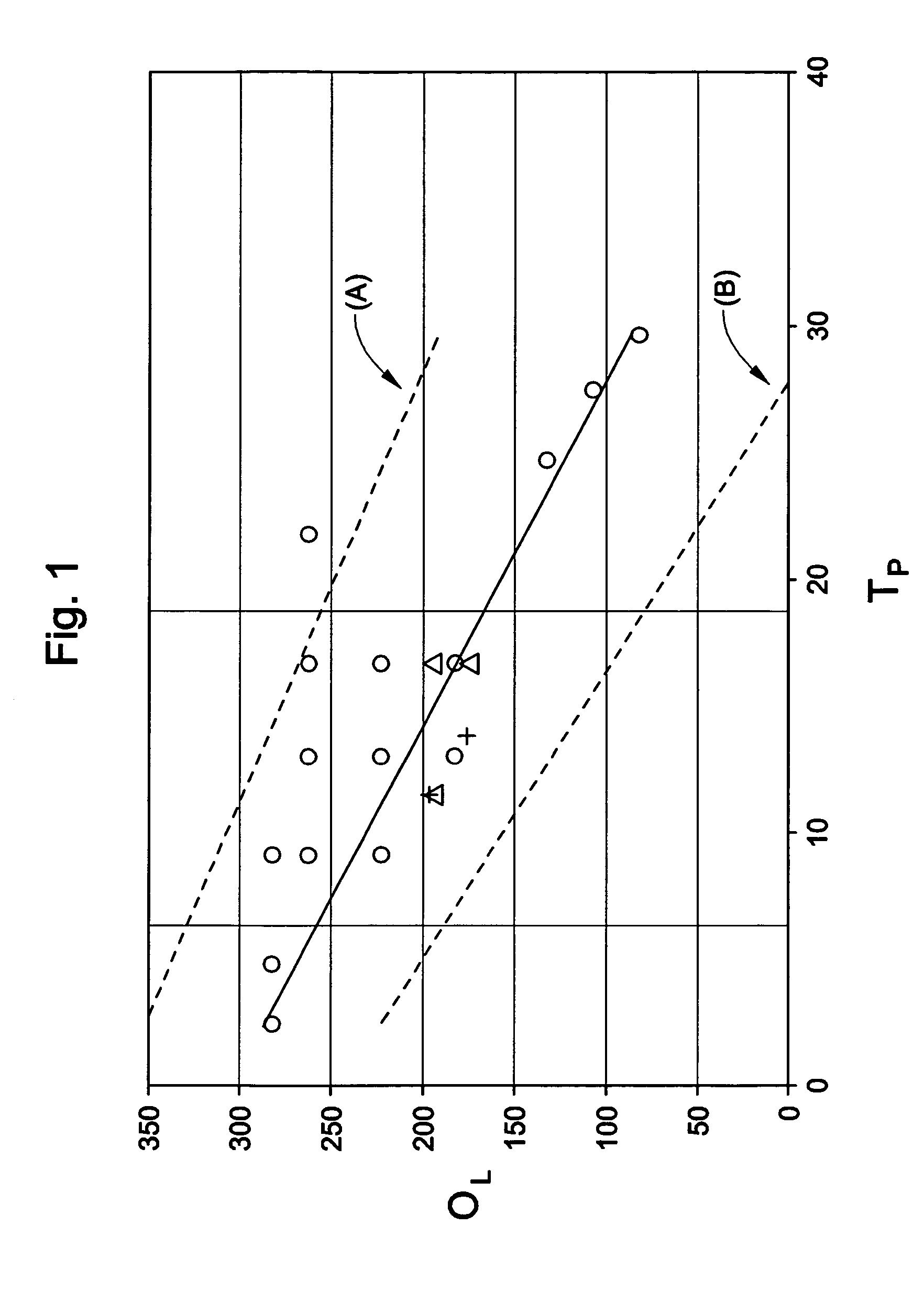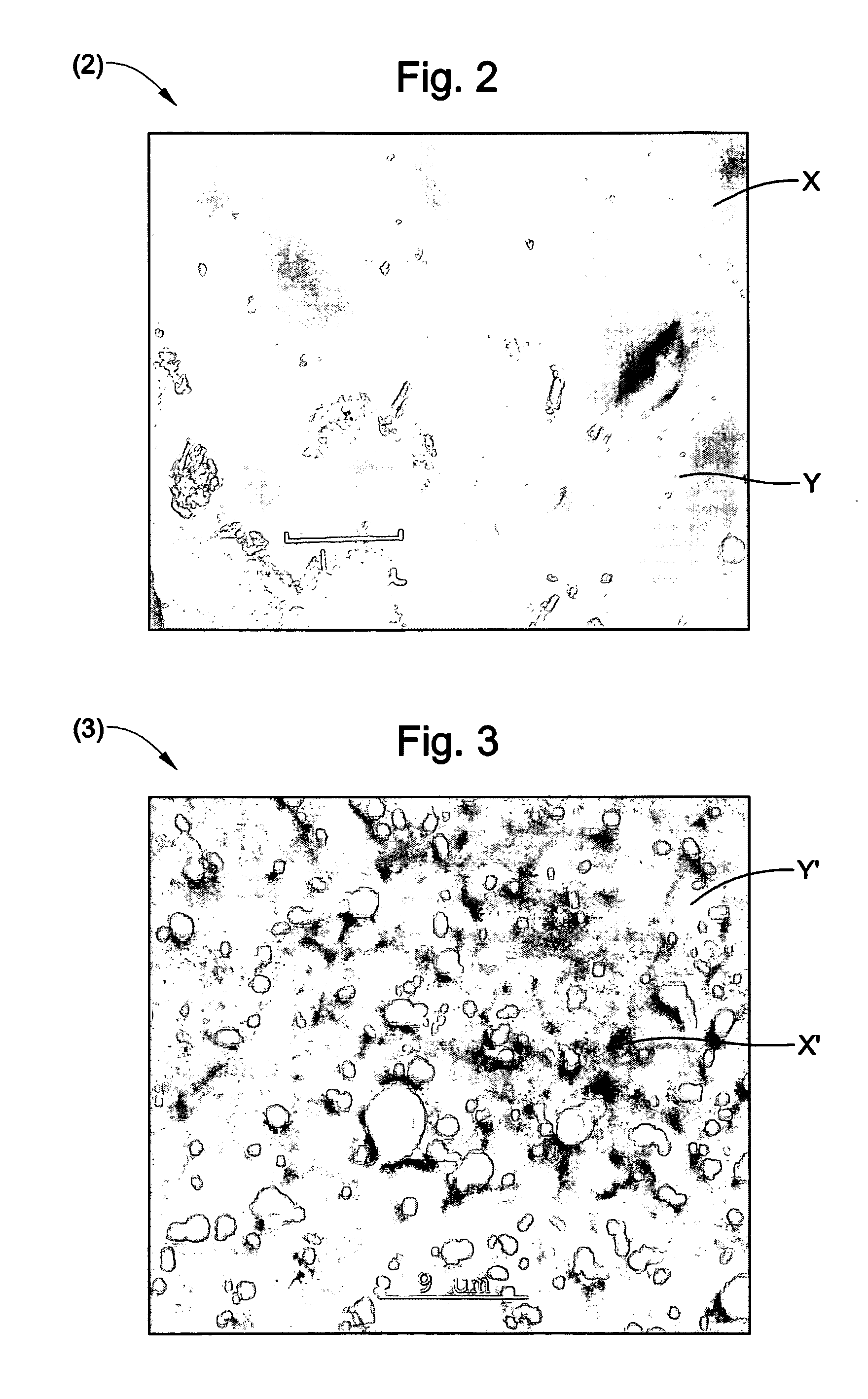Dynamic vulcanization process for preparing thermoplastic elastomers
a technology of vulcanization and thermoplastic elastomers, which is applied in the field of thermoplastic elastomers making process, can solve the problems of lowering the level of thermoplastics, loss of continuous thermoplastic phase and agglomeration of elastomeric phase, and finished articles having a “powdery” quality
- Summary
- Abstract
- Description
- Claims
- Application Information
AI Technical Summary
Benefits of technology
Problems solved by technology
Method used
Image
Examples
examples
[0069] In the Examples below the following commercial matrials were used (Table 1):
TABLE 1F008FPP homopolymer, MFR 0.8Sunoco Inc. (Chemicals)(g / 10 min).F180APP homopolymer, MFR 20.0Sunoco Inc. (Chemicals)(g / 10 min)PP5341PP homopolymer, MFR 0.83ExxonMobil Chemical Co(g / 10 min)D008MPP homoploymer, MFR 0.8Sunoco Inc. (Chemicals)(g / 10 min).VISTALON ® 3666ethylene-propylene-ExxonMobil Chemical Co(V3666)ethylidene-norbornene,Mooney ML (1 + 4, 125° C.) 50,wt % ethylene 63, wt % ENB4.2, Phr oil extension 75Vistalon ® VX1696ethylene-propylene-vinyl-ExxonMobil Chemical Conorbornene, Mooney ML(1 + 4, 125° C.) 52, wt %ethylene 62, wt % VNB 0.75,Phr oil extension 100HRJ-14247Aphenolic resin diluted in oilSchenectady ChemicalStanchlor Anhydros ™stannous chloride catalystMason Corp.Kadox ® 911zinc oxideZinc Corp. of America2-5084 Silicon Hydridesilicon hydride (SiH)Dow CorningPC085platinum catalystUnited Chemical TechnologyInc.Icecap K ®clayBurgess Pigment Co.Okerin 2709 Astor ®Hydrocarbon waxIn...
examples 1-24
[0084] In these Examples, thresholds for the lower limits of thermoplastic polymer in a vulcanizate at different oil phr were explored in a twin screw extruder. The percentage of thermoplastic polymer content in processing was varied from 29.6 to 2.4 weight % on a total polymer basis, while oil content was varied from 82.4 phr (of which 7.4 phr was free oil added into twin screw extruder) to 282.4 phr (of which 207.4 phr was free oil added into twin screw extruder). The elastomer used in the processing was V3666, and the elastomer was cured using the phenolic resin curative at 10.5 phr (of which 7.4 phr was process oil), except for in examples 22 and 23. Example 22 used 5.27 phr of HRJ-14247A (of which 3.69 phr was process oil) and example 23 used 2.63 phr of HRJ-14247A (of which 1.84 phr was process oil). The Mooney viscosity ((1+4) at 125° C.) of the elastomer without oil extension is about 250, the average molecular weight is 170,000, the weight average molecular weight is >1,000...
examples 25-26
[0095] Table 6 shows examples where the processing characteristics of the ring extruder of diameter 30 mm and L / D about 44 was used at a screw speed of 840 rpm for making soft compositions. The formulation for this invention example and comparative comprised the following (in phr): EPDM (V3666)=175 (of which 75 phr was extender oil), zinc oxide=2.0, stannuous chloride=1.26, process oil=59.1, phenolic resin=8.4 (of which 5.88 phr was diluent oil), clay=42, and wax=3.27. The amounts of PP and process oil (see below Table 5). The PP used is a blend of 6 phr of F180A and the rest, F008F. Feed rate was maintained at 150 Kg / Hr, phenolic resin in oil was used as the curative, and the phenolic resin was injected into barrel in the first 25% of the length of extruder. During the mixing process, additional oil was added before and after the addition of the curative. The reactions were carried out so that the barrel temperature profile set points of each of the TPV compositions was the same. B...
PUM
| Property | Measurement | Unit |
|---|---|---|
| melt temperature | aaaaa | aaaaa |
| melt flow rate | aaaaa | aaaaa |
| density | aaaaa | aaaaa |
Abstract
Description
Claims
Application Information
 Login to View More
Login to View More - R&D
- Intellectual Property
- Life Sciences
- Materials
- Tech Scout
- Unparalleled Data Quality
- Higher Quality Content
- 60% Fewer Hallucinations
Browse by: Latest US Patents, China's latest patents, Technical Efficacy Thesaurus, Application Domain, Technology Topic, Popular Technical Reports.
© 2025 PatSnap. All rights reserved.Legal|Privacy policy|Modern Slavery Act Transparency Statement|Sitemap|About US| Contact US: help@patsnap.com


